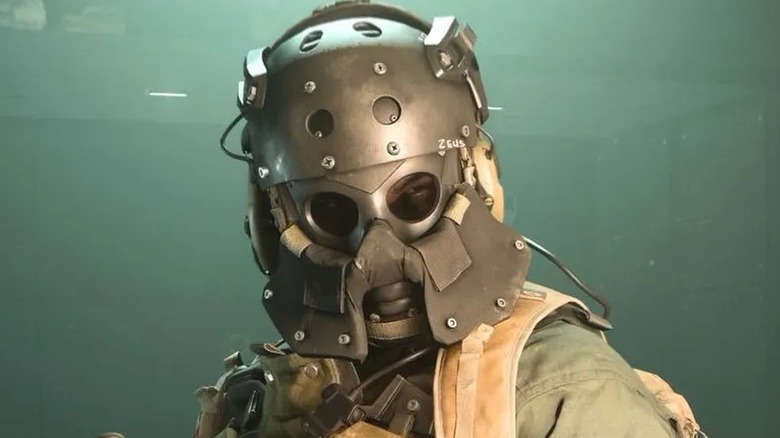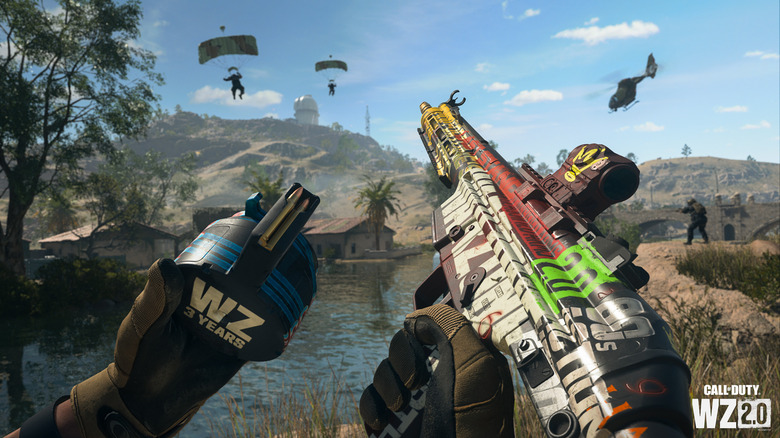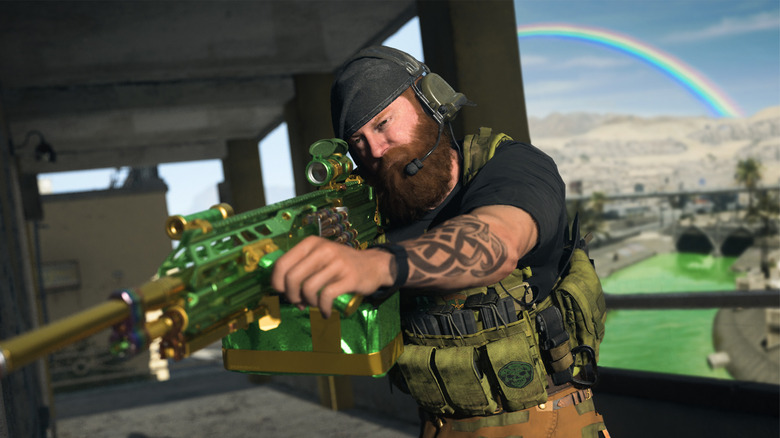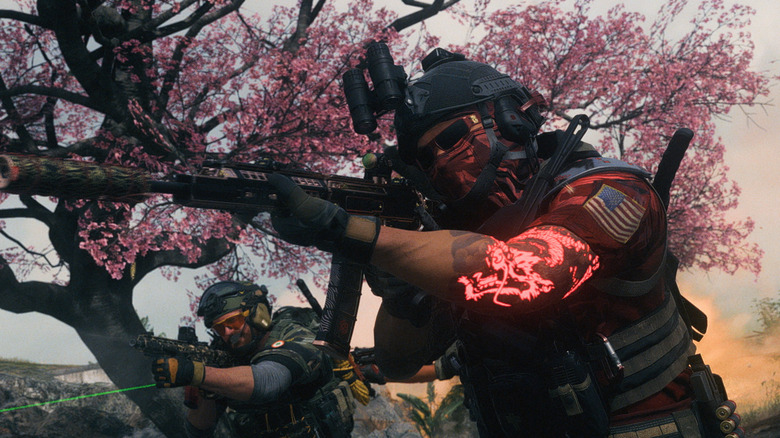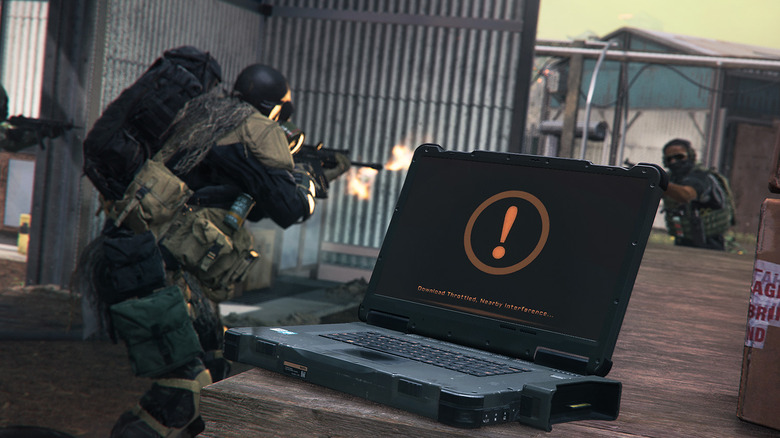Warzone 2.0: Why It's Lagging And What You Can Do To Fix It
"Call of Duty: Warzone 2.0" isn't exactly a game you want to be experiencing lag issues on — while lag isn't ideal in any game, the fast-paced real-time action requires situational awareness as well as precision to excel in means that any amount of stuttering can severely impact player performance.
Unfortunately, "Warzone 2.0" doesn't offer the smoothest gameplay experience to everyone. The game suffers from issues on both a network connection and software front, plagued with network errors like Hueneme Concord and chronic game file corruptions like Dev Error 657. There are even issues of unknown, hybrid network-and-optimization causes like Dev Error 6039 that take extensive troubleshooting to address (only to remain unresolved for many unlucky players regardless).
So, it's no surprise that even players lucky enough to not be suffering any of the more obstructive or catastrophic problems might still be facing chronic performance issues that are still detrimental to gameplay. As a relatively massive game with multiple moving parts, there are plenty of things that could be holding back your FPS or latency in "Warzone 2.0." Here's a rundown on how to troubleshoot laggy gameplay in "Call of Duty: Warzone 2.0," including possible causes and how to resolve them.
Try a few basic troubleshooting steps
Your first course of action should be to go through the most common and easily resolved causes of FPS loss and network lag. Sometimes, game lag isn't caused by the game itself any more than the conditions it's running on at the time — to ensure the most optimal runtime environment, you should be:
- Closing out as many other programs as possible (Google Chrome windows with lots of tabs are a very common culprit in CPU hogging).
- Using Task Manager to shut down unneeded background processes (such as update monitors for programs you aren't using at the time like Adobe, or game client services unrelated to "Warzone 2.0").
- Checking your network connection (this may loop back to Task Manager to shut down any processes that are downloading files in the background and sucking up bandwidth, or checking other devices on the same network that might be streaming data).
- Putting a desk fan near your console/PC or moving to a better ventilated area to help your gaming system cool itself down (this can also help with network connection if you're moving to an area closer to your main router, or close enough to outright plug into an ethernet cable instead).
Not only can these few simple steps buy you at least a few extra frames-per-second and better latency, they act as very good starting points for troubleshooting: you'll be ruling out the basic causes of lag as well as zeroing into potential problems.
Use the most optimal graphics settings to shave down FPS issues
Unfortunately, if players are having network lag that doesn't seem to affect anything else, they might be dealing with some fundamental IP address issues that can only be solved with port forwarding. In that case, they can find more information on how to hook into the best ports for the "Call of Duty" multiplayer servers in SVG's guide to solving Hueneme Concord error.
More often than not, however, most lagging issues boil down to poorly optimized graphics settings. There are a few well-known problems that are inherent to "Warzone 2.0" itself that have to be manually corrected for the best performance, the most notorious being your Spot Cache configuration. Found under "Quality" in the "Graphics” settings, players might have set it to Low alongside other graphical features they don't consider essential in order to boost performance — however, it actually must be set on High or Ultra to help with FPS stuttering.
There are two other seemingly arbitrary fixes to try in case this doesn't resolve the issues completely:
- Play "Warzone 2.0" on Fullscreen Exclusive mode instead of Windowed or the convenient and ever-popular Borderless Fullscreen Windowed mode.
- Enable Weapon Motion Blur, especially if you're experiencing slideshow-like lag at the beginning of multiplayer matches.
Unfortunately, if none of these tweaks help much, it might be worth checking your PC specs against the minimum requirements to see if your setup has the gaming horsepower to properly run the game.
Do a full rundown of all your systems and drivers
If none of the graphics tweaks worked, it's time for players to roll up their sleeves and get into the nitty-gritty of troubleshooting their lag issues. This means a full rundown of all software and hardware to check for updates:
- Windows OS/Console system software updates
- Game/game client updates
- Graphics driver updates
Unfortunately, this is the end of the troubleshooting line for console players short of resolving network latency issues. If you're still experiencing lag on Xbox and/or Playstation after the graphics settings tweaks and system updates, you might want to check out your console for any hardware or software issues.
That said, it wouldn't hurt to try a full cache clear and re-install all game files. This is a good step for PC users to take as well, as it'll rule out any corrupted game files or other inherent software issue causes for the lag. Operators can find a full rundown of how to do a complete clean refresh of game files for each of the "Warzone 2.0" platforms on SVG's guide to Dev Error 6039 — just don't forget to check the extra nooks and crannies for anyone on a PC, as games will sometimes hide extra files in directories outside the main game library like My Documents, My Games, or Appdata (found under Users in the main directory). Doing a network cache flush as outlined in SVG's Hueneme Concord Error guide won't hurt, either.
There are some extra specific solutions for PC users
There are a few issues that are specific to certain PC specs: For example, NVIDIA users should try and rollback their drivers. Sometimes NVIDIA's driver updates can cause incompatibilities with "Warzone 2.0" and do more harm than good. In order to do this, players will want to head into Device Manager, then Display Adapters, then find their graphics card. Open its Drivers menu, then select Roll Back Driver and restart the PC. The bad news is that sometimes the rollback option will be grayed out entirely. In that case, operators will need to uninstall the driver, then head to the NVIDIA website to manually find and install an older version of the drivers for their graphics card.
However, it's not all bad for NVIDIA users — "Warzone 2.0" also features an NVIDIA-specific performance option that you can enable for a better performance called NVIDIA DLSS. Ooperators can even configure this one in-game, in the Quality tab under Graphics. Just select NVIDIA DLSS in the Upscaling/Sharpening drop-down options, and see if it's helped at all.
If anyone is still getting bad frames, here are a couple final tweaks to try:
- If you're on Windows 11, you should also try disabling Core Isolation, a new feature that supposedly offers extra security against unreliable drivers and programs at the cost of CPU hogging.
- Adjust Hardware-accelerated GPU Scheduling in your Windows graphics settings — turning it on or off might offer you a little performance boost.

